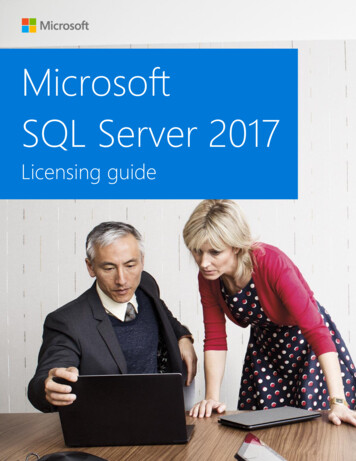
Transcription
MicrosoftSQL Server 2017Licensing guide
ContentsOverview3SQL Server 2017 editions4SQL Server and Software Assurance7How SQL Server 2017 licenses are sold9Server and Cloud EnrolmentSQL Server 2017 licensing models11Core-based licensingServer CAL licensingLicensing SQL Server 2017 components15Licensing SQL Server 2017 in a virtualized environment16Licensing individual virtual machinesLicensing for maximum virtualizationLicensing SQL Server in containers20Licensing individual containersLicensing containers for maximum densityLicensing SQL Server for the Analytics Platform System24Advanced licensing scenarios and detailed examples26Licensing SQL Server for high availabilityLicensing SQL Server for application mobilityLicensing SQL Server for non-production useLicensing SQL Server in a multiplexed application environmentAdditional product information34SQL Server 2017 migration options for Software Assurance customersAdditional product licensing resources 2017 Microsoft Corporation. All rights reserved.This document is for informational purposes only. MICROSOFT MAKES NO WARRANTIES, EXPRESS OR IMPLIED, IN THIS SUMMARY.Microsoft provides this material solely for informational and marketing purposes. Customers should refer to their agreements for a full understanding of their rights andobligations under Microsoft’s Volume Licensing programs. Microsoft software is licensed not sold. The value and benefit gained through use of Microsoft software and servicesmay vary by customer. Customers with questions about differences between this material and the agreements should contact their reseller or Microsoft account manager.Microsoft does not set final prices or payment terms for licenses acquired through resellers. Final prices and payment terms are determined by agreement between thecustomer and its reseller. Eligibility for Software Assurance benefits varies by offering and region and is subject to change. The terms and conditions of your Volume LicenseAgreement and the terms and conditions under which any specific Software Assurance benefits are offered will take precedence in the case of any conflict with the informationprovided here. For eligibility criteria and current benefit program rules, see the Microsoft Product List.
OverviewThis licensing guide is for people who want to gain a basic understanding of how Microsoft SQL Server 2017 database software is licensed through Microsoft Volume Licensing programs. This guide does notsupersede or replace any of the legal documentation covering SQL Server 2017 use rights. Specific productlicense terms are defined in the product Software License Terms—or in the case of Microsoft VolumeLicensing—in the Microsoft Volume Licensing agreement under which the software was acquired and/or theMicrosoft Volume Licensing Product Terms. This licensing guide is not a legal use rights document. Programspecifications and business rules are subject to change.Microsoft SQL Server 2017 Licensing guide3
SQL Server 2017 editionsSQL Server 2017 is offered in two main editions to accommodate the unique feature, performance and pricerequirements of organizations and individuals: Enterprise Edition is ideal for applications requiring mission critical in-memory performance, security andhigh availability. Standard Edition delivers fully featured database capabilities for mid-tier applications and data marts.The editions are offered in a straightforward, tiered model that creates greater consistency across the producteditions, features and licensing. Enterprise Edition includes all the capabilities available in SQL Server 2017.Through a consistent programming interface across all editions, it is easier than ever for developers andpartners to build and upgrade applications that take advantage of advanced performance, security, and datamart or data warehouse features – regardless of scale, from Express to Enterprise.SQL Server Standard Edition sets the bar for rich programming capabilities, security innovations, and fastperformance for mid-tier applications and data marts. SQL Server Standard Edition can easily be upgraded toEnterprise Edition as workloads scale or for mission critical workloads without requiring an application re-write.Enterprise Edition continues to deliver the highest levels of mission critical scalability, availability, andperformance as well as maximum virtualization rights with Software Assurance.SQL Server 2017 now brings the performance and security of SQL Server to the Linux platform. Customers willhave the option to deploy on Windows or Linux platforms through a single license construct. The SQL Server2017 license provides flexibility to deploy across these platforms, and as your needs change over time you willhave the licensing to enable changes in deployment patterns.Microsoft SQL Server 2017 Licensing guide4
SQL Server 2017 EditionsSQL Server 2017 CapabilitiesStandardEnterpriseCore-based or Server CALCore-basedProgrammability & developer tools(T-SQL, CLR, Data Types, FileTable**, JSON, Graph Data support) Manageability(Management Studio, Policy-Based Management) Advanced OLTP (In-memory OLTP*, Operational analytics*) Data warehousing (In-Memory ColumnStore*, partitioning, datacompression, change data capture**, database snapshot) Basic security (Always Encrypted, row-level security, data masking, basicauditing, separation of duties) Basic corporate business intelligence(Multi-dimensional models, Basic tabular model, enhanced connectors,new transformations, object-level security, ragged hierarchies)** Basic R and Python integration (Connectivity to R Open and Python,limited parallelism)** Basic High Availability (2-node single database failover, non-readablesecondary) Basic Adaptive Query Processing (Interleaved execution) Licensing optionsAdvanced High Availability (Always On Availability Groups, multi-node,multi-DB failover, readable secondaries) Advanced Adaptive Query Processing (Batch mode memory grantfeedback, Batch mode adaptive joins), Automatic Plan Correction Advanced security (Transparent Data Encryption) Enterprise Data Management(Data Quality Services, Master Data Services)** Advanced corporate business intelligence**(Advanced tabular model, direct query, in-memory analytics, Mobile BI) Advanced R and Python integration (Availability to run on GPUs and fullparallelism through Machine Learning Services)** This table shows a comparison of key capabilities across the main SQL Server 2017 editions.*Subject to memory and core limitations in Standard, Web and Express Editions**Available for Windows Server onlyOther specialty editions of SQL Server 2017 include Developer Edition, which is licensed for non-productionuse; the freely downloadable and distributable Express Edition, and the next generation SQL Server ParallelData Warehouse, which is available as a component of the Analytics Platform System integrated applianceoffering. Note that SQL Server Parallel Data Warehouse is enabled through SQL Server Enterprise (covered laterin this document).With SQL Server 2017, the Web Edition remains available only under the Microsoft Services Provider LicenseAgreement (SPLA).For general information on each of the SQL Server 2017 editions, visit er-2017-editionsMicrosoft SQL Server 2017 Licensing guide5
For more information on the Analytics Platform System visit ts/analytics-platform-system/For detailed product specifications and a full feature-by-feature comparison of the SQL Server 2017editions, visit v sql.130).aspxSQL Server2017 EditionDatabase Engine (DBE) capacity limitsAnalysis Services (AS) andReporting Services (RS) capacity limits*Max computecapacityMax memoryutilization - DBEMax DB SizeMax computecapacityMax memoryutilization - ASMax memoryutilization – RSOS max12 TB524 PBOS maxOS maxOS max20 core limit12 TB524 PB20 core limitOS maxOS maxStandardLesser of 4 socketsor 24 cores128 GB524 PBLesser of 4 socketsor 24 cores64 GB (MOLAP)16 GB (Tabular)64 GBWebLesser of 4 socketsor 16 cores64 GB524 PBLesser of 4 socketsor 16 coresN/A64 GBExpressLesser of 1 socketor 4 cores1 GB10 GBLesser of 1 socketor 4 coresN/A4 GB (AdvancedServices Ed.)OS maxOS maxOS maxOS maxOS maxOS maxEnterprise Per CoreEnterpriseServer CALDeveloperThis table shows a comparison of the key capacity limits across the SQL Server 2017 editions.*Analysis Services and Reporting Services are available for Windows Server onlyFor more information on the compute capacity limits for each edition of SQL Server 2017, 3760(v sql.130).aspxMicrosoft SQL Server 2017 Licensing guide6
SQL Server and SoftwareAssuranceSoftware Assurance (SA) for Volume Licensing helps boost IT productivity by enabling customers to get themost from Microsoft software products. SA benefits—including 24x7 support, deployment planning services,user and technical training, and the latest software releases and unique technologies—are combined in onecost-effective program.For SQL Server, using these benefits can help customers improve productivity and help IT efficiently deploy andmanage SQL Server software. As hardware capacity and licensing needs expand, SQL Server customers with SAcoverage can enjoy the benefit of adding incremental licenses without worrying about the software versionlicensed. Software licenses and use rights are version-specific and as such, licenses for different softwareversions cannot be combined when licensing a single operating system environment. As a benefit of havingaccess to the latest version of SQL Server software, SA customers licensed under the core licensing model (forexample) can easily combine current version core licenses with future version core licenses, without the need totrack or otherwise reassign covered licenses based on software version alone.Note: All licenses must be covered with SA and product use rights do not change when using downgraderights to deploy prior software versions.Software Assurance benefits overviewBenefitDescriptionUnlimited virtualizationAllows customers to run any number of instances of SQL Server 2017 Enterprise Edition software in anunlimited number of VMs. Applicable under the core licensing model only.Failover ServersAllows customers to install and run passive SQL Server 2017 instances in a separate OSE or server for highavailability in anticipation of a failover event.Power BI Report ServerAllows SQL Server Enterprise Edition customers to run Power BI Report Server.Machine Learning Server for HadoopAllows SQL Server Enterprise Edition customers to run Machine Learning Server for Hadoop.License Mobility within aserver farmAllows reassignment of SQL Server 2017 licenses within a server farm more than once every 90 days. Does notapply to SQL Server PDW.License Mobility through SAAllows license reassignment of SQL Server 2017 to third party shared servers. Does not apply to SQL ServerPDW.Disaster Recovery RightsAllows backup instances of SQL Server 2017 software for temporary use in a server dedicated to disasterrecovery.SQL Server applianceupdatesAllows access to new product features and functionality between major appliance software releases. Applies toSQL Server PDW deployments only.Additional benefits for SCE customersIn addition to the benefits noted above, Server Cloud Enrollment (SCE) customers may also qualify for premiumbenefits, including Unlimited Problem Resolution Support.This table provides an overview of the benefits of Software Assurance.Microsoft SQL Server 2017 Licensing guide7
For example, by combining SQL Enterprise Edition with the benefits provided through SA, customers unlock thefull power of SQL Server: Stay current with all SQL Server features Access an unlimited number of virtual machines Modernize to the cloud with existing licenses Take advantage of high availability scenarios at no additional licensing cost Extend your data estate through advanced analytics on Hadoop with Machine Learning Server for Hadoop Generate data visualizations on premises with Power BI Report ServerRefer to the Volume Licensing Product Terms for more details on these benefits and additional license grantsavailable to SQL Server customers with SA, including any additional terms and conditions that may apply.For more information on Software Assurance benefits, visit -programs/software-assurance-default.aspxMicrosoft SQL Server 2017 Licensing guide8
How SQL Server 2017 licensesare soldSQL Server 2017 software licenses are sold through channels designed to meet the unique needs of customers.These sales channels include online retailers offering full packaged product (FPP) licenses of SQL Serversoftware, Original Equipment Manufacturers (OEMs) offering pre-installed licenses with their hardware systems,as well as Licensing Solutions Partners (LSPs) and Enterprise Software Advisors (ESAs) offering SQL Serversoftware through Microsoft Volume Licensing programs for end-customer organizations.For customers with as few as five users, Microsoft offers licensing programs to help reduce administrativeoverhead and software management costs, while enabling product licensing on an ongoing basis at aconsiderable discount. The various licensing options enable customers to choose the program that works bestfor their management and operational needs. Comprehensive programs that offer Software Assurance as a fixed benefit include the Open Value (OV),Open Value Subscription (OVS), Enterprise Agreement (EA), Enterprise Subscription Agreement (EAS) andthe Server and Cloud Enrollment (SCE). Transactional programs include Open and the Microsoft Products and Services Agreement (MPSA).Server and Cloud EnrollmentThe Server and Cloud Enrollment (SCE) is an enrollment under the Microsoft Enterprise Agreement that enableshighly committed customers to standardize broadly on one or more key server and cloud technologies fromMicrosoft. In exchange for making an installed base-wide commitment to one or more components of theServer and Cloud Enrollment, customers receive the best pricing and terms, plus other benefits, includingcloud-optimized licensing options and simplified license management.Microsoft also offers programs that can meet the specific needs of organizations that partner with Microsoft toprovide additional software and services, such as the Microsoft Independent Software Vendor (ISV) RoyaltyLicensing Program and the Microsoft Services Provider License Agreement (SPLA).Microsoft SQL Server 2017 Licensing guide9
SQL Server 2017 editionsRetailFPP/ESDEnterprise EditionStandard Edition Volume licensing programsThird partyOPENMPSAEA/EAS/SCEISVRSPLA Web EditionExpress EditionFree downloadDeveloper EditionFree downloadThis table shows the primary channel availability for SQL Server 2017 software licenses. Every edition may not be available in all channels or licensingprograms in all regions.For more information about Microsoft Volume Licensing Programs, download the Volume LicensingReference Guide at 3c1-a783-4d48-a7adf404abdb1e7d/Microsoft Volume Licensing Reference Guide.pdfFor details on the Microsoft Server and Cloud Enrollment, options/enterprise.aspxMicrosoft SQL Server 2017 Licensing guide10
SQL Server 2017licensing modelsWith SQL Server 2017, Microsoft offers a variety of licensing options aligned with how customers typicallypurchase specific workloads. The Server CAL licensing model provides the option to license users and/ordevices and then have low-cost access to incremental SQL Server deployments. For customers who cannotcount users or require premium database capabilities, Microsoft licenses SQL Server in a core-based licensingmodel. Core-based licensing gives customers a more precise measure of computing power and a moreconsistent licensing metric, regardless of whether solutions are deployed on physical on-premises servers, or invirtual or cloud environments.SQL Server 2017EditionsDescriptionEnterpriseFor applications requiring mission critical inmemory performance, security and high availabilityStandardDelivers fully featured database capabilities formid-tier applications and data martsLicensing optionsServer CALPer CoreRequirements SQL Server CALs requiredwhen licensing Server CALThis table compares the licensing options for each of the main SQL Server 2017 editions.Core-based licensingUnder the Per Core licensing model, each server running SQL Server 2017 software or any of its components(such as Reporting Services or Integration Services) must be assigned an appropriate number of SQL Server2017 core licenses. The number of core licenses needed, depends on whether customers are licensing thephysical server or individual virtual operating system environments (OSEs).Unlike the Server CAL licensing model, the Per Core model allows access for an unlimited number of users ordevices to connect from either inside or outside an organization’s firewall. With the Per Core model, customersdo not need to purchase additional client access licenses (CALs) to access the SQL Server software.Microsoft SQL Server 2017 Licensing guide11
This figure depicts the representations of the physical server, physical processor, physical and virtual cores, virtual machines and containers that are used inthis guide.Physical serverA server is a physical hardware system capable of running server software. A hardwarepartition or blade is considered to be a separate physical hardware system.Physical processorA processor is generally a physical chip that resides in a physical socket of the hardwarepartition and contains one or more cores.Physical coreEach physical processor contains smaller processing units called physical cores. Someprocessors have two cores, some four, some six or eight, and so on.Virtual coreA virtual core is a virtual representation of one or more hardware threads.Hardware threadA hardware thread is either a physical core or a hyper-thread in a physical processor.Physical OperatingSystem EnvironmentA physical operating system environment (OSE) is configured to run directly on a physicalhardware system and is all or part of an operating system instance.For detailed definitions of these and other key licensing terms, please refer to the Microsoft Volume Licensing Product Terms.How to license SQL Server 2017 using the Per Core licensing modelWhen running SQL Server in a physical OSE, all physical cores on the server must be licensed. Softwarepartitioning does not reduce the number of core licenses required, except when licensing individual virtualmachines (VMs). A minimum of four core licenses is required for each physical processor on the server.To determine and acquire the correct number of core licenses needed, customers must:1Count the total number of physical cores in the server.2Purchase the appropriate number of core licenses required for the server. Core licenses are sold in packs of two, so customers must dividethe number of licenses required by two to determine the actual number of line items (licensing SKUs) to order.For more details on the Per Core licensing model, including key terms and licensing definitions, downloadthe Introduction to Per Core Licensing Volume Licensing Brief briefs/licensing-by-cores.aspxMicrosoft SQL Server 2017 Licensing guide12
The Per Core licensing model is appropriate when: Deploying the SQL Server 2017 Enterprise Edition (including using the SQL Server Parallel Data Warehousedeployment option) or SQL Server 2017 Web Edition software. Deploying internet or extranet workloads, systems that integrate with external-facing workloads (even ifexternal data goes through one or more other systems), or w
software, Original Equipment Manufacturers (OEMs) offering pre-installed licenses with their hardware systems, as well as Licensing Solutions Partners (LSPs) and Enterprise Software Advisors (ESAs) offering SQL Server s


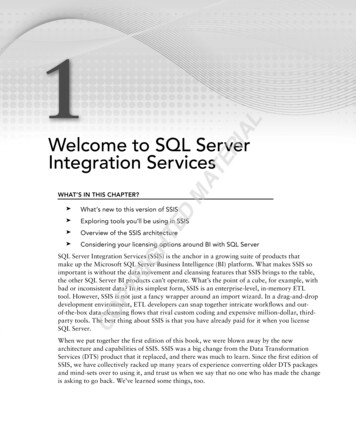
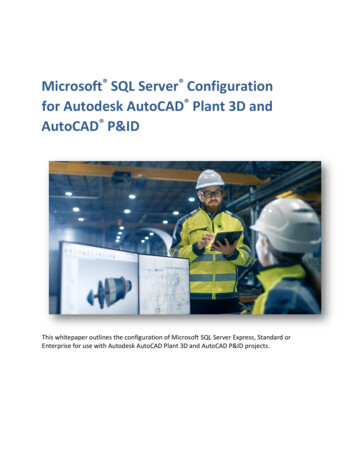
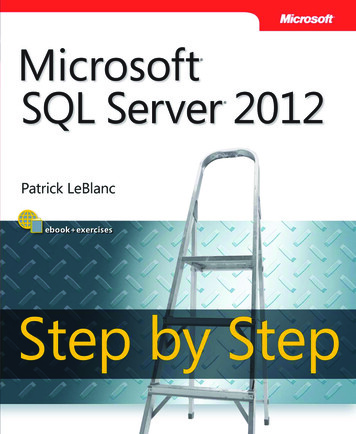
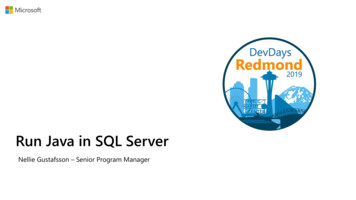

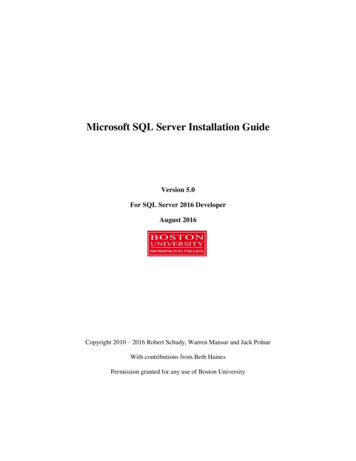


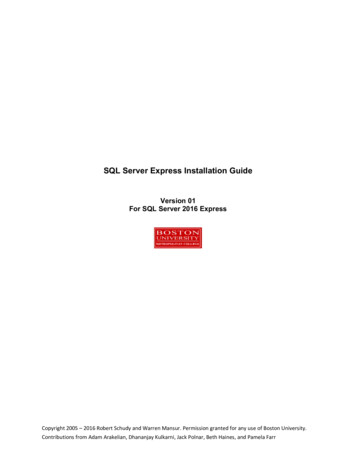
![SQL Server TSQL [Read-Only]](/img/17/sql-server-tsql.jpg)